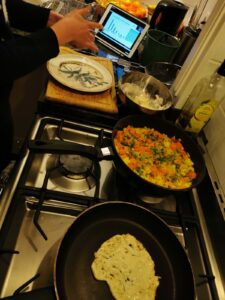All posts
Conference confessions and digital digestions
I’m running through a huge hallway. Some doors are closed, others open. People standing crammed in a little corner trying to hear and see what is going on inside. Which room was it again? I check my phone, an enormous schedule on a tiny, tiny screen. This should be it. Still breathing heavily, I’m contemplating whether I should open the door. Has the presentation already started? Or are they still discussing questions from the previous talk? I decided to take the plunge. The door opens with an awkward creaking noise. People sitting in the room look at me, distracted. The talk has started, and it is not the one I am looking for.

Sound familiar? This is one of the many experiences when attending large scientific conferences. The past two weeks have been conference time for me. One in Berlin and one in Lanzarote, attending both from the comfort of my home. Last week’s topic was science communication, this week it is everything related to microplastic. The schedule was intense; 12 hours a day in three parallel sessions. It looked exhausting. But while enjoying dinner cooked by my boyfriend and following a session together where some of my colleagues were presenting, I suddenly realised that the normal exhaustion I experience at conferences was not there. In fact, there are so many benefits to digital conferences that I’m wondering; why did this format not exist until a pandemic forced us to go digital?
The change was extremely sudden. From the start of lockdown, none of the conferences I was planning to attend were canceled. They immediately changed to an online format. There was, and still is, a lot of improvement possible to make the digital experience more smooth, more entertaining, more interactive. But the advantages are slowly outweighing any of the downsides of the digital format.
Take the example at the start of this post. We don’t have to make the tough decision; to stay one hour in the same room or to frantically run between sessions? The other session is now only one mouse click away! We don’t disturb anyone by ‘opening the door’. And for the crazy people, you can even follow two sessions at the same time. On top of that, you can suddenly share the experience with your family. Where you would normally need some sort of badge to enter the conference building, many of the digital conferences I attended so far did not require any password to follow a session.
That leads us to the two most important aspects of digital conferences; inclusiveness and openness. Take for example this week’s conference, the MICRO international conference 2020. There was no abstract fee, no registration fee, no travel costs and all sessions were streamed on a public website. To put it in other words, it was completely free and open for everyone. The organisation might have been a little shocked with the sudden increase in abstracts submitted, but they were probably expecting that (and glad to see the interest in their event soar!). And people don’t seem to care too much about the time differences as long as the science is interesting enough. Last week, during the science communication conference, I had a very engaging and interesting chat with someone from Australia. It was 4am Down Under.
Then the sessions themselves. This week, all presentations were prerecorded, with the very strict rule that they were not allowed to be longer than 7 minutes. So it was technically impossible to go over time. As a result there was this amazing 50/50 balance of providing an overview and having an active discussion. Questions could be asked via a shared notepad and the session’s chair would use these for the discussion. Remove the scary hand raising, the awkward walk to the microphone, and you suddenly get so many more (young!) scientists asking questions! And when it is time for the next speaker, the discussion can just continue on the notepad.
Seeing an interesting result? Want to capture the conclusions, but the screen is too far away to take a photograph? Just hit that print screen button. Share a link to that new piece of code you created, or that interactive website you have been talking about. We’re all supporters of open science, and this digital format provides a range of possibilities for doing so.
And don’t get me started on the environmental impact of scientists flying across the globe for meetings. Rough estimates indicate that 10-30% of the CO2 emissions from Dutch universities stem from academics flying [1], and moving to a digital format significantly reduces our carbon footprint [2]. So after all our efforts to do good for the Earth through our research, did we really need a pandemic to accelerate our good intentions?
***
ps. Another little bonus, you can check out my prerecorded presentation (and those of my colleagues) HERE!!

